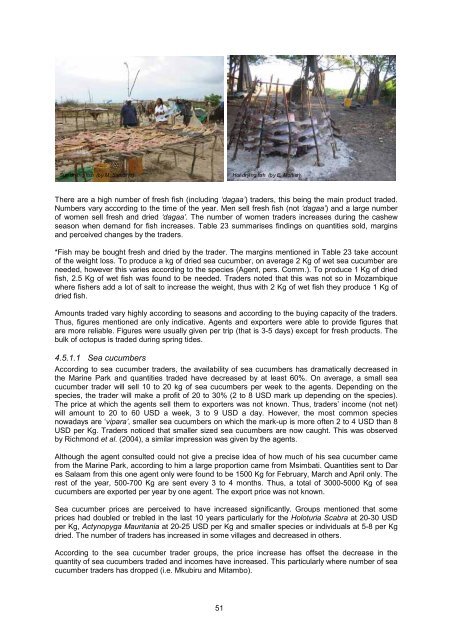a socio-economic baseline assessment of the mnazi bay - IUCN
a socio-economic baseline assessment of the mnazi bay - IUCN
a socio-economic baseline assessment of the mnazi bay - IUCN
You also want an ePaper? Increase the reach of your titles
YUMPU automatically turns print PDFs into web optimized ePapers that Google loves.
Sun drying fish (by M. Samoilys)<br />
Hot drying fish (by E. Mottier)<br />
There are a high number <strong>of</strong> fresh fish (including ‘dagaa’) traders, this being <strong>the</strong> main product traded.<br />
Numbers vary according to <strong>the</strong> time <strong>of</strong> <strong>the</strong> year. Men sell fresh fish (not ‘dagaa’) and a large number<br />
<strong>of</strong> women sell fresh and dried ‘dagaa’. The number <strong>of</strong> women traders increases during <strong>the</strong> cashew<br />
season when demand for fish increases. Table 23 summarises findings on quantities sold, margins<br />
and perceived changes by <strong>the</strong> traders.<br />
*Fish may be bought fresh and dried by <strong>the</strong> trader. The margins mentioned in Table 23 take account<br />
<strong>of</strong> <strong>the</strong> weight loss. To produce a kg <strong>of</strong> dried sea cucumber, on average 2 Kg <strong>of</strong> wet sea cucumber are<br />
needed, however this varies according to <strong>the</strong> species (Agent, pers. Comm.). To produce 1 Kg <strong>of</strong> dried<br />
fish, 2.5 Kg <strong>of</strong> wet fish was found to be needed. Traders noted that this was not so in Mozambique<br />
where fishers add a lot <strong>of</strong> salt to increase <strong>the</strong> weight, thus with 2 Kg <strong>of</strong> wet fish <strong>the</strong>y produce 1 Kg <strong>of</strong><br />
dried fish.<br />
Amounts traded vary highly according to seasons and according to <strong>the</strong> buying capacity <strong>of</strong> <strong>the</strong> traders.<br />
Thus, figures mentioned are only indicative. Agents and exporters were able to provide figures that<br />
are more reliable. Figures were usually given per trip (that is 3-5 days) except for fresh products. The<br />
bulk <strong>of</strong> octopus is traded during spring tides.<br />
4.5.1.1 Sea cucumbers<br />
According to sea cucumber traders, <strong>the</strong> availability <strong>of</strong> sea cucumbers has dramatically decreased in<br />
<strong>the</strong> Marine Park and quantities traded have decreased by at least 60%. On average, a small sea<br />
cucumber trader will sell 10 to 20 kg <strong>of</strong> sea cucumbers per week to <strong>the</strong> agents. Depending on <strong>the</strong><br />
species, <strong>the</strong> trader will make a pr<strong>of</strong>it <strong>of</strong> 20 to 30% (2 to 8 USD mark up depending on <strong>the</strong> species).<br />
The price at which <strong>the</strong> agents sell <strong>the</strong>m to exporters was not known. Thus, traders’ income (not net)<br />
will amount to 20 to 60 USD a week, 3 to 9 USD a day. However, <strong>the</strong> most common species<br />
nowadays are ‘vipara’, smaller sea cucumbers on which <strong>the</strong> mark-up is more <strong>of</strong>ten 2 to 4 USD than 8<br />
USD per Kg. Traders noticed that smaller sized sea cucumbers are now caught. This was observed<br />
by Richmond et al. (2004), a similar impression was given by <strong>the</strong> agents.<br />
Although <strong>the</strong> agent consulted could not give a precise idea <strong>of</strong> how much <strong>of</strong> his sea cucumber came<br />
from <strong>the</strong> Marine Park, according to him a large proportion came from Msimbati. Quantities sent to Dar<br />
es Salaam from this one agent only were found to be 1500 Kg for February, March and April only. The<br />
rest <strong>of</strong> <strong>the</strong> year, 500-700 Kg are sent every 3 to 4 months. Thus, a total <strong>of</strong> 3000-5000 Kg <strong>of</strong> sea<br />
cucumbers are exported per year by one agent. The export price was not known.<br />
Sea cucumber prices are perceived to have increased significantly. Groups mentioned that some<br />
prices had doubled or trebled in <strong>the</strong> last 10 years particularly for <strong>the</strong> Holoturia Scabra at 20-30 USD<br />
per Kg, Actynopyga Mauritania at 20-25 USD per Kg and smaller species or individuals at 5-8 per Kg<br />
dried. The number <strong>of</strong> traders has increased in some villages and decreased in o<strong>the</strong>rs.<br />
According to <strong>the</strong> sea cucumber trader groups, <strong>the</strong> price increase has <strong>of</strong>fset <strong>the</strong> decrease in <strong>the</strong><br />
quantity <strong>of</strong> sea cucumbers traded and incomes have increased. This particularly where number <strong>of</strong> sea<br />
cucumber traders has dropped (i.e. Mkubiru and Mitambo).<br />
51
















